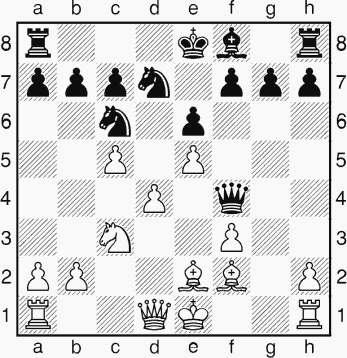
Back in the late 1960s, one man started a revolution in the world’s view of chess. His name was Bobby Fischer.
Bobby was brash, charismatic, spoke his mind and stuck to his principles. He was also a winner. He beat the whole Soviet “machine” single-handed, at a time when, politically, that was a very good thing for an American to do.
Bobby’s success and notoriety brought unprecedented publicity to chess and greatly increased the prizes typical at chess tournaments. As Bill Hartston pithily put it, it was the start of the Financial Age.
Suddenly chess was a game for the young and for the rebellious. Chess was sexy.
The general media, however, has always seemed a little uneasy about chess. All too often the line taken is how weird chess players are, or how boring the game is (to those who don’t understand anything about it). Either that or they are “trying to make chess exciting” (as if it isn’t already).
In the case of Bobby Fischer, the press coverage had a most unfortunate effect, and he developed a deep distrust of the media. Since he didn’t give interviews, reporters had free rein to make up whatever they liked about him. So far as the non-chess-playing world was concerned, the image the media created was Fischer. The subject of Fischer is too big to discuss in detail here, but for a sympathetic, chess-player’s view of the great man, I refer you to Frank Brady’s biography Profile of a Prodigy (if you can get hold of a copy) and Yasser Seirawan’s No Regrets, which is an account of Fischer’s 1992 return match against Spassky and recounts Seirawan’s conversations with Fischer.
Chess experienced an explosion of interest in 1972 when Fischer beat Boris Spassky in their world championship match in Reykjavik. Chess was in the news! Television news bulletins recounted the latest stories from Reykjavik, whether on or off the board. Sales of chess books and equipment sky-rocketed and chess club membership increased dramatically.
Unfortunately, Fischer played no competitive chess in the years after winning the title, and as it became clear that the king would not return, media interest in chess began to wane.
Occasionally there is a blip in media interest, but nothing that causes a really large increase in the popularity of chess. For instance, one might have expected the Kasparov vs Short match in London in 1993 to have a major long-term effect on the popularity of chess in Britain. As one would expect, sixty hours of chess on television, albeit largely of low quality, and chess motifs splashed on the sides of London buses had a dramatic short-term effect. Chess book sales went up by between 300% and 500% and chess club membership reportedly rose by a quarter. However, Nigel Short was no Bobby Fischer, and after he lost the match, everything quickly returned to normal – or indeed worse than before the match. Sponsorship of chess in Britain has fallen to an almost non-existent level since 1993. The reason for such a negative effect is hard to pin-point: perhaps it was Nigel’s at times uninspiring performance in television interviews, the largely superficial coverage on television, or the hyping of Nigel’s chances prior to the match causing what was an extremely valiant effort to be viewed as a dismally poor showing. Or perhaps potential sponsors for chess heard the stories that ticket sales for the match were very poor, and so decided that sponsoring chess was a bad option.
If chess is to become more popular, really good television coverage is essential. How to present chess well on television effectively is no mystery. An excellent approach was refined and perfected in Britain by BBC2 with their Master Game series. The programmes were cheap to make and got excellent viewing figures. The series was produced as follows. First, a knock-out chess tournament was played. One of the merits of this format is that it discourages draws. Although each game was to form the basis of a half-hour programme, the time limit was similar to that used in normal tournament games. (Why not play good chess, and then show it accelerated, rather than show bad chess in real-time?) Then the players went to the studio, were given plenty of wine and recounted their thoughts during the game. They were not allowed to cite lengthy variations, but had to describe their ideas in words. A re-enactment of critical moments of the game was then filmed. What the viewer saw on screen was a large clear diagram of the board position, with any squares or pieces that were mentioned in the commentary highlighted. The two players were shown by the side of the board, with their thoughts and commentaries dubbed in.
For club players this provided wonderful insights into how grandmasters and international masters think. The viewing figures were unusually large for the slot when the programme was broadcast – so large that a good proportion of the viewers must have had only a rudimentary knowledge of the game. Yet they stayed tuned.
To me, this is the way forward for chess on television. The Master Game did not “try to make chess exciting”, but rather portrayed the excitement of chess.
Unfortunately, The Master Game was axed in the early 1980s, and has not since been reinstated. This is apparently due to no one in a position of sufficient power at BBC2 believing in the potential for chess on television – in spite of the evidence provided by the viewing figures. Perhaps I am being cynical, but I believe that those who have no experience of chess are all too willing to cling to a preconceived notion of chess and the people who enjoy the game, rather than believe the hard evidence.
Perhaps someone who can change things is reading this. If so, please look at the demographics of chess-players, and investigate the idea of chess on television further.
Until some visionary brings chess back to our television screens, we will have to make do with online coverage, books, magazines and the traditional newspaper columns. Many quality newspapers feature a chess column. Some columns feature up-to-the-minute chess news, while others focus on features of more general chess interest, for instance games by great players. Regrettably, some columns are occasionally used to political effect too.
If your favourite newspaper doesn’t cover chess, or does not cover it well, write to the editor and tell him. A few well-written letters making the point can have a very considerable effect. By all means write to television companies too!
My closest encounter with the general media came in 1994, when I set a new chess world record.
I was involved in this rather unusual event from Wednesday 18th May to Saturday 21st May at the London Chess Centre – a successful attempt on the World Record for marathon blitz chess playing. My task was to play more than 500 five-minute games, more or less non-stop, with just short rest breaks (how long and how many depending mainly on how quickly I played – clearly 500 five-minute games would take more than 80 hours if both players used all of their clock time). Just to make it more of a challenge, I had to score at least 75%, and my opponents had to have an average grading of 150 ECF (1800 Elo), with ungradeds counting only as 125 ECF (1600 Elo).
Those who agreed to play against me fell into two main groups:
1) inexperienced, aspiring players who viewed it as a learning experience – a chance to play someone who knows a bit about chess;
2) strong players (often friends of mine I’d managed to rope in) who viewed it as a bit of fun, or were going to be at the Chess Centre anyway.
My policy was clear – blow away players of type 1 using about half a minute on my clock, so I could afford a bit of time to think against the good players. My experience at my club in Denmark came in handy here, since there I often played with a one-to-five minute time handicap.
The event went pretty smoothly, though with plenty of excitement and amusing incidents along the way. Naturally, at times I did feel a bit lousy, though nothing like as bad as I’d expected. I certainly didn’t come close to hallucinating, or throwing fits or anything. My ...Bc8-f5 (over a pawn on d7), in game number 498 was my only illegal move in the course of the event.
The whole event was rather hectic, with a couple of radio interviews to be slotted in on top of everything else. I turned up at LBC Radio at 6.30 a.m. on the 18th and was interviewed by two people who were obviously so famous that no one bothered to tell me their names! My inexperience let me down somewhat, and unfortunately I failed to dive in when there was a fleeting chance to work in a plug for my latest book. By Saturday morning, I’d had time to work out just what was involved in these interviews, so when another radio station, GLR, spoke to me, I was sure to mention everything I could think of.
The following are a few of the memorable games from the event. Firstly, one against Natasha Regan, a member of the England women’s team.
Burgess – N. Regan
London blitz (Game 466) 1994
1 e4 Nf6 2 e5 Nd5 3 d4 d6 4 c4 Nb6 5 f4 dxe5 6 fxe5 Nc6 7 Be3 Bf5 8 Nc3 e6 9 Nf3 Bg4 10 Be2 Bxf3 11 gxf3 Qh4+ 12 Bf2 Qf4 13 c5 Nd7

14 Ne4
I tried 14 Bb5 in a few games, but Natasha had found something decent there in the end; either 14...f6 or 14...Be7 followed by ...f6.
14...f6 15 Qa4 0-0-0 16 Rd1
Natasha has played a suggestion from my book The Complete Alekhine, but at the time I did not realize it was a bad one. Instead of the move played, 16 d5 Ncxe5 17 c6! is extremely good for White.
16...fxe5 17 Bg3 Qh6 18 Rd3
I’d spent the previous game grinding down someone who had played 2 Nc3 against my Alekhine Defence and gone all-out for the draw, so such blatant violence is perhaps forgivable.
18...exd4 19 Rb3 Bxc5 20 Rxb7 Kxb7 21 Ba6+ Kb8 22 Qxc6 Qc1+ 23 Kf2
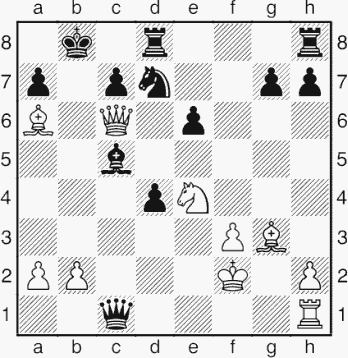
23...Qxb2+
Oh no!! A few moves back I’d only reckoned on 23...d3+? (discovered checks are the first things one considers, and with such a time limit, second things don’t tend to get looked at!) 24 Kg2 Qxb2+ 25 Kh3 when it seems that White does in fact win as spectacularly as I had hoped when launching my kamikaze rook:
a) 25...Bd6 26 Nxd6 Qb6 27 Rb1 Qxb1 28 Ne8 Qf1+ 29 Kh4 g5+ 30 Kxg5 and Black will be mated soon.
b) 25...e5 26 Nc3 with the rather horrible threats of Rb1 and Nb5.
24 Kf1 Qb6 0-1
After I had broken the record, Grandmaster John Nunn was kind enough to give me a few games. I lost three and won one – a score I would have been happy with under any conditions! Here are the first two games:
Burgess – Nunn
London blitz (Game 504) 1994
1 d4 Nf6 2 c4 g6 3 Nc3 Bg7 4 e4 d6 5 Nf3 0-0 6 Be2 e5 7 0-0 Nc6 8 d5 Ne7 9 Bg5 Nh5 10 Ne1 Nf4 11 Nd3 Nxe2+ 12 Qxe2 h6 13 Bd2 f5 14 f4
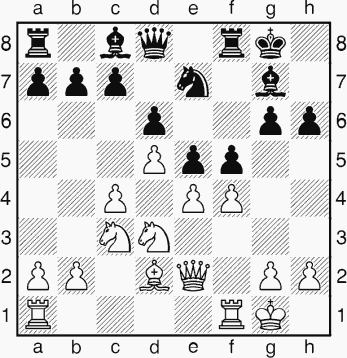
14...fxe4
A good alternative is 14...c6, as played in Burgess–S.Pedersen, Assens 1990.
15 Nxe4 Nf5
15...exf4 is possible, but a little obliging; indeed Neil McDonald played this against me in game number 321 (but with the pawn still on h7, having played the less accurate move 12...f6) and he had slightly the worse of a draw.
16 fxe5 dxe5 17 Bc3 c6 18 dxc6
“Extra pawn” is Fritz’s perceptive comment on 18 Nxe5 cxd5 19 cxd5.
18...Nd4 19 Bxd4 Qxd4+ 20 Kh1 Rxf1+ 21 Rxf1 bxc6 22 Nf6+
22 Ndc5 is possible.
22...Bxf6 23 Rxf6 Bf5 24 Nf2 Rb8 25 b3
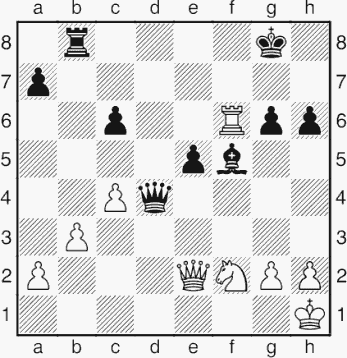
My position’s beginning to creak.
25...Rd8
John Nunn provided the variation 25...e4 26 Rxc6 e3 27 Nd1 Rd8 28 Nxe3 Re8, winning for Black. At the time John just couldn’t believe that after his actual choice, 26 g4 was possible, but in fact things now become unclear again.
26 g4 Kg7 27 Rxc6 Bd7 28 Rc7 Qd6
The rest of the game was played without much time on my clock. Black’s compensation is not utterly clear, but had my flag not fallen, I imagine I would have dropped a piece somehow.
29 Rxa7 Kg8 30 Rxd7 Rxd7 31 Ne4 0-1 (time)
Nunn – Burgess
London blitz (Game 505) 1994
1 e4 Nf6 2 e5 Nd5 3 d4 d6 4 Nf3 Bg4 5 Be2 c6 6 c4 Nb6 7 Nbd2
7 exd6 exd6 8 Nbd2 gives Black more options since the b8-knight can often come to a6. But 7 Ng5 is a more critical test of Black’s opening play, and possibly a reason to consider putting the knight on c7 instead of b6.
7...N8d7
7...dxe5 8 Nxe5 is good for White.
8 exd6
I believe this is White’s best way to play an exchange line here. Now 8 Ng5 Bxe2 9 e6 f6 is just unclear.
8...exd6 9 0-0 Be7

10 h3
10 Re1 0-0 transposes to a game Yudasin–Timoshenko, which continued 11 a4 a5 12 Ra3 with advantage for White.
10...Bh5 11 b3 0-0 12 Bb2 a5
This is a debatable decision, holding up White on the queenside at the cost of some weaknesses.
13 a4
This is possibly not necessary.
13...d5 14 c5 Nc8 15 Re1
White could try 15 Bd3.
15...Bf6
Threatening ...Nxc5.
16 Rc1 Re8 17 Nf1
17 Qc2 could be considered.
17...Nf8 18 Ng3 Bg6
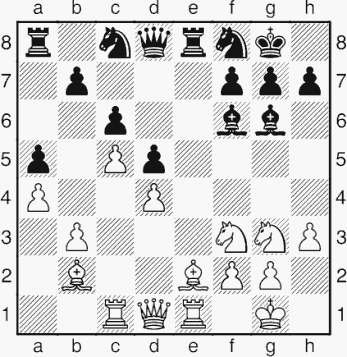
A fairly standard type of position for the opening line as a whole. Black’s counterplay springs from the vulnerability of the d4-pawn and the f4-square (and if White really asks for it, ...b6 at the right moment), whereas White may look to the weak(?) a5-pawn, b6-square, e-file domination and maybe some kingside play.
19 Bf1
All the other legal moves are possible, perhaps most notably 19 Qd2 Ne6 20 Bd3 and 19 Bd3 Rxe1+ 20 Nxe1 Ne7.
19...Ne7
Again not the only move; 19...Ne6 is plausible, as is 19...Rxe1 20 Qxe1 Ne6 21 Ne5 Ne7 22 Nxg6 Nxg6 when Black’s grip on f4 gives him counterplay.
20 Ne5
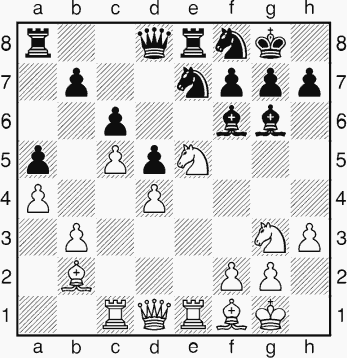
20...Nf5
I am not entirely sure about the sequence in which the next four moves occurred; what follows looks the most plausible, but John assures me that it was really 20...Ne6 21 Qd2? (21 Nxg6 Nxg6 22 Bd3 Ngf4 is probably critical) 21...Nf5 22 Nxf5 Bxf5, i.e. that he allowed me to win an exchange with 21...Bg5, and I missed it. Strange, but I do recollect playing ...Ne6 somewhere around here. Oops?!
21 Nxf5 Bxf5 22 Qd2 Ne6 23 g3?
This loses a pawn, but the alternative would be to retreat either the queen or the knight.
23...Ng5
White cannot defend his h-pawn and prevent a capture on e5 followed by a killing fork on f3.
24 Qf4 Bxh3 25 Kh2 Be6
25...Bxf1 is somewhat clearer.
26 f3 h6 27 Bd3 Nh7 28 Qd2 Qc8
Black has a sound extra pawn with a good position.
29 Qg2 Bf5 30 Bxf5 Qxf5 31 Re3 h5
This was intended as a random attacking gesture (a better idea than losing on time), but turns out to be appropriate and quite strong.
32 Qf2 Ng5 33 f4 Qh3+ 34 Kg1 Ne4 35 Qg2 Qxg2+ 36 Kxg2 Bxe5 37 dxe5 f5
Again, rather a good idea, played mainly by instinct.
38 Bd4 Re6
Thankfully, a plan.
39 Kh3 Kf7 40 Ree1 Rg6 41 Re3 Re8 42 Rf1 Rg4 43 Rc1 Re6 0-1
On time, but White’s kingside is in trouble in any case. With or without a few more preparatory moves, ...h5-h4 will cause devastation. Rather an aesthetically pleasing way to use the extra pawn – if White had an h-pawn, this wouldn’t be such a big deal.
Here are a few statistics from the event:
During the periods when I was at the board, I averaged 8½ games an hour. This suggests that on average I spent less than two minutes of my clock time on each game.
As a rough estimate, I played about 20,000 moves: one every ten seconds for the whole of three days, with an average of less than three seconds thinking time per move.
Given that chess problems are one of the features that have traditionally appeared in newspaper chess columns, this seems an appropriate place to give the solutions to the two “White to play and checkmate in two moves” problems from the previous chapter. Note that in a chess problem, the task is not merely to win the game, but to achieve the stated task; thus, a way to give mate in three moves, while good in a game situation or in a study, is of no use in a mate-in-two problem.